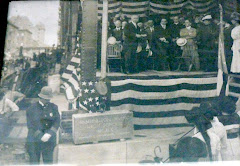Émilie Chauchoin was born in Saint-Mandé, Seine, France, to Georges Claude, a banker, and Jeanne Loew Chauchoin. After some financial reverses, her family emigrated to New York City in 1906. Colbert eventually became a naturalized citizen of the U.S.
Colbert studied at Washington Irving High School, where her speech teacher, Alice Rossetter helped her overcome a slight lisp. Rossetter encouraged her to audition for a play she had written, and Colbert made her stage debut at the Provincetown Playhouse in The Widow's Veil, at the age of fifteen.
She then attended the Art Students League of New York and worked as a stenographer, a salesclerk in womens' clothing, and a tutor in order to pay her expenses. She intended to become a fashion designer but after she attended a party with the playwright Anne Morrison she was offered a three-line role in Morrison's new play. She appeared on the Broadway stage in a small role in The Wild Westcotts (1923). Inspired to pursue a career in theater, Colbert ended her studies and embarked on a stage career in 1925. She adopted the name "Claudette Colbert" as her stage name two years later; she had been using the name of Claudette since high school, and Colbert was the maiden name of her maternal grandmother.
After signing a five-year contract with the producer Al Woods, Colbert played ingénue roles on Broadway from 1925 through 1929. During her early years on stage, she fought against being typecast as a maid, and received critical acclaim on Broadway in the production of The Barker (1927), playing a carnival snake charmer, a role she reprised for the play's run in London's West End.
She co-starred with Fredric March in Manslaughter (1930), and received positive reviews for her performance as a rich girl, jailed for manslaughter. The New York Times wrote, "It cannot be denied that Claudette Colbert – given an even chance – is capable of excellent acting." She was briefly paired with March, and they made four films together, including Dorothy Arzner's Honor Among Lovers (1931), which fared well at the box-office. She sang in her role opposite Maurice Chevalier in the Ernst Lubitsch musical The Smiling Lieutenant (1931), which was nominated for an Academy Award for Best Picture, and was acknowledged by critics for her ability to assert herself opposite the more experienced Miriam Hopkins.
Cecil B. DeMille cast her as the Roman empress Poppaea in his historical epic, The Sign of the Cross (1932), opposite Fredric March. In one sequence, Colbert bathes in a marble pool filled with asses' milk, a scene that came to be regarded as an example of Hollywood decadence prior to the enforcement of the Production Code. Later the same year she played in The Phantom President, which was one of Paramount's biggest failures of the year. Other successes of this period included Tonight Is Ours (1933) with Fredric March and Torch Singer (1933), with Ricardo Cortez. In 1933, Colbert renegotiated her contract with Paramount to allow her to appear in films for other studios. However, Cecil B. DeMille's Four Frightened People (1934) failed to find a substantial audience.
During 1934, Colbert's film career flourished. Of the four films she made that year, three of them – the historical biography, Cleopatra, the romantic drama, Imitation of Life and the screwball comedy, It Happened One Night were nominated for Academy Awards for Best Picture.
Colbert's success allowed her to renegotiate her contract, raising her salary. In 1935 and 1936, she was listed in the annual "Quigley Poll of the Top Ten Money Making Stars", which was compiled from the votes of movie exhibitors throughout the U.S. for the stars that had generated the most revenue in their theaters over the previous year.
She received a second Academy Award nomination for her role in the hospital drama, Private Worlds (1935).
In 1936, she signed a new contract with Paramount Pictures, which required her to make seven films over a two-year period, and this contract made her Hollywood's highest paid actress. This was followed by a contract renewal in 1938, after which she was reported to be the highest paid performer in Hollywood with a salary of $426,924. Her films during this period include The Gilded Lily (1935) and The Bride Comes Home (1935) with Fred MacMurray, She Married Her Boss (1935), with Melvyn Douglas, Under Two Flags (1936), with Ronald Colman, Maid of Salem (1937), again with MacMurray, Tovarich (1937), with Charles Boyer, Bluebeard's Eighth Wife (1938), with Gary Cooper, Zaza (1939), with Herbert Marshall, Midnight (1939), with Don Ameche and It's a Wonderful World (1939), with James Stewart.
Monday, April 28, 2008
Claudette Colbert Biography: Part 1
Posted by David Ballela at 9:21 PM
Labels: claudette colbert
Subscribe to:
Post Comments (Atom)







0 Comments:
Post a Comment